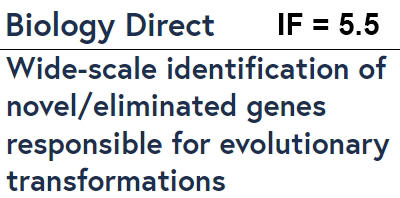Press-room / news / Science news /
WINEGRET: а method for Wide-scale Identification of Novel and Eliminated Genes Responsible for Evolutionary Transformations
Scientists from the Laboratory of Molecular Bases of Embryogenesis at the Shemyakin-Ovchinnikov Institute of Bioorganic Chemistry, Russian Academy of Sciences, in collaboration with researchers from the Kharkevich Institute for Problems of Information Transmission, Russian Academy of Sciences, have pioneered a method for wide-scale identification of genes whose loss or emergence during evolution correlates with the disappearance or emergence of distinct phenotypic or physiological traits.
The majority of evolutionary transformations involving the appearance/disappearance of certain phenotypic or physiological traits at different stages of evolution are either linked to rearrangements in cis-regulatory elements controlling gene activity or to changes directly within protein-coding gene sequences. However, more recently, an increasing body of evidence suggests that significant evolutionary changes can also be associated with the loss/emergence of entire genes. The targeted wide-scale identification of such genes has remained an unsolved challenge due to its complexity until now. Meanwhile, uncovering these genes and further studying their functions is crucial not only for deciphering the fundamental basis of evolutionary changes but also for understanding the mechanisms underlying the development of numerous genetic disorders.
To address this challenge, the authors of the paper have developed the WINEGRET method, so named for two reasons: firstly, it is composed of two heterogeneous methods, and secondly, it derives from the initials of the brief description of the problem tackled by this method: Wide-scale Identification of Novel/Eliminated Genes Responsible for Evolutionary Transformations. The core idea of the method is to identify relevant genes as simultaneously satisfying two criteria: (1) they must have been lost/emerged at the same evolutionary stage as the disappearance/emergence of the trait of interest, and (2) the expression of these genes must significantly change during the development of the specific trait in the chosen model species exhibiting the said trait.
To identify genes that meet the first requirement, the authors developed an original algorithm and computer program, enabling the discovery of orthologs (direct homologs) of genes from the chosen model species exhibiting the trait of interest in other species without relying on existing ortholog databases (which are far from comprehensive and often yield a substantial number of false predictions). Instead, the approach involves a wide-scale screening of genomes using criteria of best homology and local genomic synteny. As a result, the sought-after genes that emerged/disappeared during an evolutionary stage coinciding with the appearance/disappearance of the trait of interest are determined. These are genes whose orthologs are present/absent in all species possessing/lacking the trait of interest but are absent /present in all species lacking it.
Genes meeting the second requirement are identified through deep RNA sequencing extracted at various stages of development of the said trait. The final list of genes of interest is derived by intersecting the lists of genes that satisfy the specified two criteria.
As a proof of concept, the authors employed the developed method to search for genes absent in modern amniotes (reptiles, birds, and mammals) that lack the ability to regenerate limbs, but present in well-regenerating anamniotes (fish and amphibians) where these genes participate in limb regeneration. As a result, 57 such genes were identified, out of which 30 become actively expressed after tail amputation in tadpoles of the chosen model species, the Xenopus tropicalis frog, while 27, conversely, significantly decrease their expression. For three of these genes, c-c motif chemokine 4, eotaxin-like, and a previously unknown gene named sod4 by the authors, important roles in tail regeneration were demonstrated. Interestingly, the latter gene turned out to be a member of a new fourth Cu/Zn superoxide dismutase family, SOD4, lost in amniotes and first described in this study. As is known, superoxide dismutases convert superoxide radicals into hydrogen peroxide, which in turn serves as a signaling agent in numerous intra- and extracellular processes, including playing a crucial role in the regulation of regeneration.
This research was supported by the Russian Science Foundation grant 23-74-30005 and published in the journal Biology Direct.

Fig. 1. Using of the WINEGRET method for finding genes regulating body appendages regeneration in fish and amphibians but absent in regeneration-incompetent reptiles, birds and mammals.
A. Declining capability to regenerate large body appendages, i.e., limbs and tail, in the line of vertebrates from fish and amphibians to placental mammals. Shown are groups of vertebrates that emerged sequentially in evolution.
B. Scheme of the WINEGRET method using the example of a search for genes absent in mammals, birds, and reptiles but present in fish and amphibians and involved in the tail regeneration of Xenopus tropicalis frog tadpoles.
august 17, 2023


